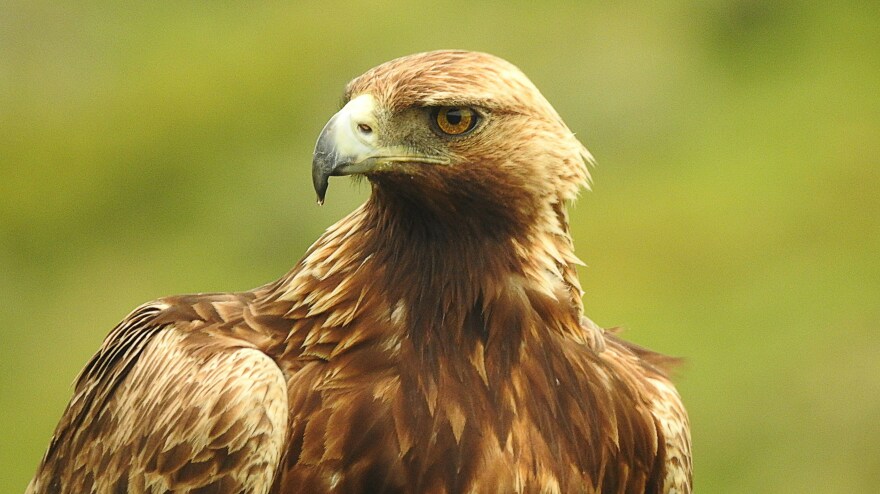A recently released document assesses the status of eastern golden eagles and lays out a host of recommendations for better protecting these apex predators. It could be particularly useful to conservationists, wildlife officials, and others in Kentucky, where golden eagles are known to migrate over winter.
The golden eagle population in eastern North America isn't very well known, according to Todd Katzner, a research wildlife biologist with the U.S. Geological Survey and one of the author's of the plan put forward by the Eastern Golden Eagle Working Group. He says this document aggregates what is known in one place "so that it can be a source of information for people who may want to take action on behalf of golden eagles, or may want to understand the situation in eastern North America."
The report notes the western golden eagle is genetically distinct from the eastern golden eagle. The golden eagle population in western North America is thought to be stable or slightly declining. In the U.S., it's about 30,000 to 35,000 birds. That number is estimated to be much smaller for eastern golden eagles — just 5,000 to 10,000 individuals, though Katzner says that number likely used to be smaller.
"That population appears to have grown in recent years, apparently, after DDT was no longer used in much of the U.S.," Katzner adds.
That's a good example of one reason why golden eagles are important. As apex predators — animals at the top of the food chain — they're good indicators of the overall health of an ecosystem. Their presence has been documented to correspond with higher levels of biodiversity, better ecosystem health, and more robust ecosystems, he explains.
"I think a really good example of this is the response of these golden eagles in eastern North America to DDT. ... When DDT started to impact populations of birds throughout North America, what we saw were declines in the size of the golden eagle populations. Then once that stressor was removed, it took a few years, but golden eagle populations have begun to rebound. That's a nice example of how the presence of golden eagles is an indicator of the well-being, the health, the state of the natural ecosystem."
The report notes the western golden eagle is genetically distinct from the eastern golden eagle. Golden eagles are migratory. In eastern North America they typically breed in Canada and then fly south during the colder months to winter in places like the Appalachians.
"Some of them do get into Ohio every year. There are a couple of reports from eastern Ohio, in particular the hill country in eastern Ohio gets wintering golden eagles, and then a lot of them also get into Kentucky," Katzner explains. "We have done some tracking of those birds from Kentucky and they tend to migrate through the Great Lakes area and up into Canada where, if they're old enough and mature breeders, they will occupy a breeding territory during the summer and then head back down to the U.S. for winter."
The birds are more prevalent in Kentucky because it offers more of the habitat they prefer: large blocks of forest with moderate to high topographic relief — think of places like the Appalachians, Blue Ridge Mountains and Smoky Mountains.
The conservation plan
The plan lays out four key conservation objectives:
- Maintain or increase breeding population size
- Protect habitat in breeding, migration, and wintering areas
- Maintain or develop long-term monitoring programs
- Reduce threats and anthropogenic causes of mortality
Katzner notes the plan is a series of information and recommendations that any group or agency may consider to help protect the species. Each of these four areas have a subset of suggestions. The first point of the conservation plan isn't very relevant to conservationists concerned with golden eagles in Kentucky or Ohio, however the other three objectives could be considered, according to Katzner.
"We did not target specific people or agencies; we wanted to really distribute this as broadly as possible and get it into as many people's hands as possible. Kentucky does have a Department of Fish and Wildlife Resources that has been involved in golden eagle conservation programs in the past, and we are certainly hopeful that that agency finds this information useful. There are also other federal agencies (like) the U.S. Fish and Wildlife Service and the Forest Service — both may also find this information useful and relevant to wildlife management in Kentucky."
RELATED: Ohio's bald eagle population continues to rise
Bernheim Arboretum & Research Forest south of Louisville has long worked with golden eagles and the Eastern Golden Eagle Working Group. Conservation Director Andrew Berry told Kentucky Public Radio member station Louisville Public Media he hopes the plan will increase awareness about golden eagles, which in turn, could lead to better protections.
"As these threats continue to increase, we could see decreases in [eastern golden eagle populations] in the coming decades if people aren't aware, and if people aren’t focused on how to mitigate some of these threats," Berry said.
Like bald eagles, golden eagles are scavengers, eating from animal carcasses. They are susceptible to some of the same threats as bald eagles, namely lead poisoning from old ammunition they may ingest from scavenging an animal that's been shot but not recovered. Katzner also points out hunters can use established methods of setting leg-hold traps so they don't result in a "bycatch" (non-target animal) of golden eagles.



